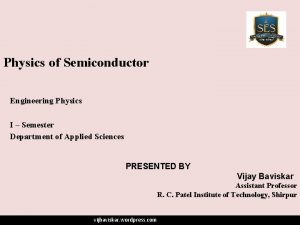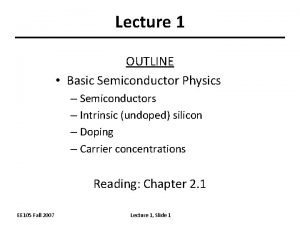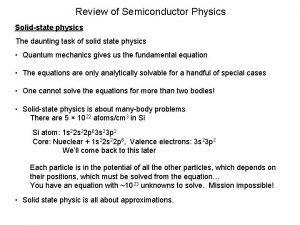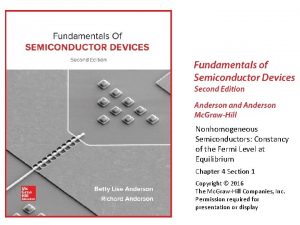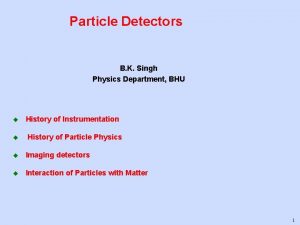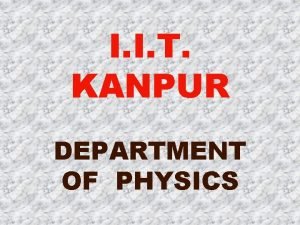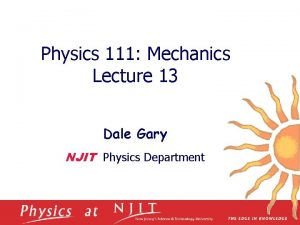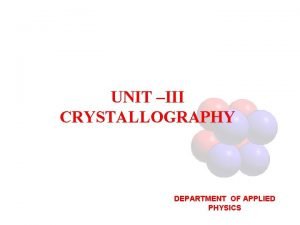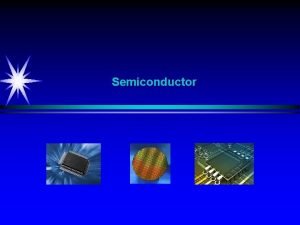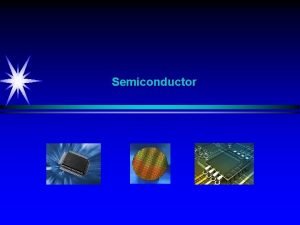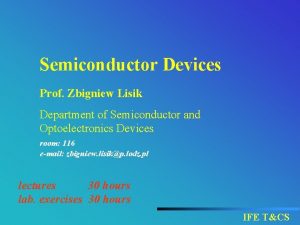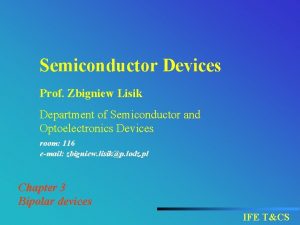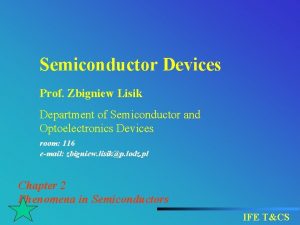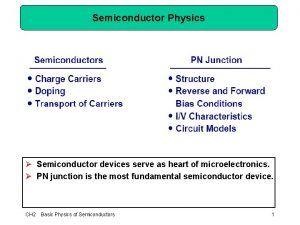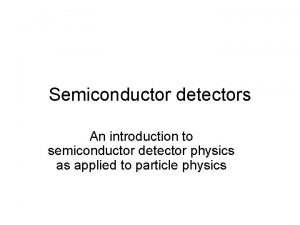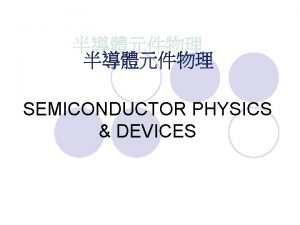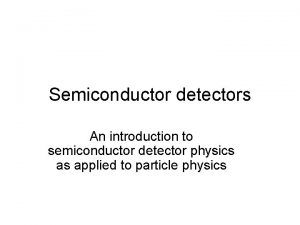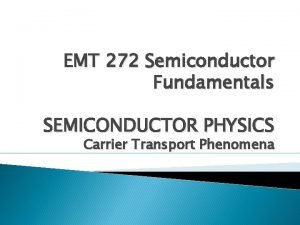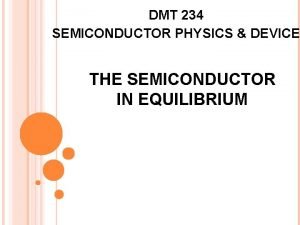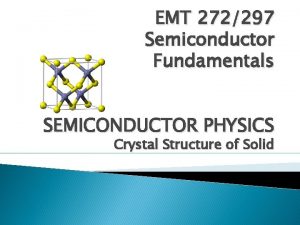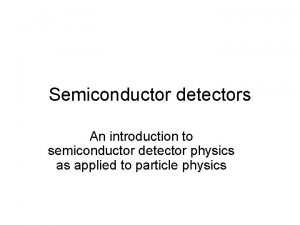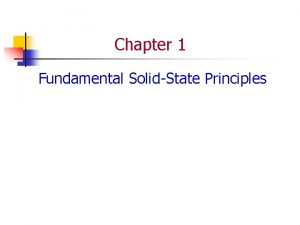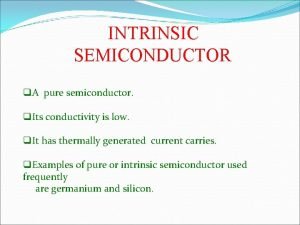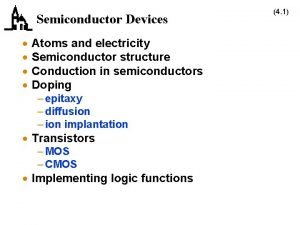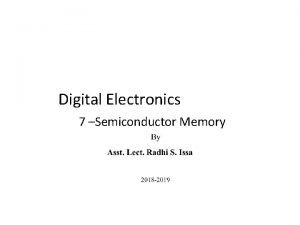Physics of Semiconductor Engineering Physics I Semester Department


































- Slides: 34

Physics of Semiconductor Engineering Physics I – Semester Department of Applied Sciences PRESENTED BY Vijay Baviskar Assistant Professor R. C. Patel Institute of Technology, Shirpur vijbaviskar. wordpress. com

COURSE OBJECTIVE Students will be able to classify material on basis of band gap Students will be able to define types of Semiconductor. Students will be able to explain conduction in intrinsic semiconductor.

COURSE OUTLINE Classification of Material on Band gap. Intrinsic Semiconductor. Extrinsic Semiconductor. Electrical conductivity in Semiconductor.

UNIT-IV PHYSICS of SEMICONDUCTOR MARKS-16 • Introduction – 1) 2) 3) 4) 5) 6) 7) Band theory of solids Classification of semiconductor Intrinsic & Extrinsic semiconductor Fermi level Conductivity equation for semiconductor pn-junction diode Hall effect

Band theory of solids • According to theory of ‘Hydrogen’ atom. • Isolated single atom has single energy level.

Band theory of solids • Electrons in outermost orbit call as valence electrons, these are interact with each other. • Valence electrons orbital's combine to form molecular orbital's. • Energy diff. become smaller & smaller as number atoms are increased.

Energy level splitting of two atoms • When two atoms come close, the original level split into two energy levels. • Slimily three atoms come close, the original level split into three energy levels.

Energy levels splitting of solids • When ‘N’ atoms interact to each other an energy level to spilt up into ‘N’ levels. • Energy levels splitting The transformation of single energy level into two or more separate energy levels • Splitting of single energy level into band is responsible for Electrical, Magnetic , optical properties of solids.

Energy levels splitting of solids

Band theory of solids • Energy level splitting is greatest for outermost electrons & least for inner electrons. • Energy level splitting is increase with the decreasing the atomic spacing. • Energy band – the manifold levels resulting from splitting are so closely spaced that they form a virtual continuum.

Electron Distribution

Energy band structure of Lithium (3) -

Energy band structure of Beryllium (4) -

Energy band structure of Carbon (6) -

Energy band structure of Silicon (14) -

Definitions • Valence Band (V. B. ) - • Conduction Band (C. B. ) - • Forbidden Band (E. g. ) -

Classification of solids on Band theory • Insulator • Conductor • Semiconductor -

INSULATOR

CONDUCTOR

SEMICONDUCTOR

Concept of Hole

Type of semiconductor • Intrinsic (pure) Semiconductor • Extrinsic (impure) Semiconductor

Intrinsic semiconductor

Intrinsic semiconductor

Extrinsic (impure) Semiconductor • Depending upon which type of impurity is added to pure semiconductor they are classify into two type • P-type semiconductor • N-type semiconductor

P-type semiconductor

N-type semiconductor

Intrinsic semiconductor

P-type semiconductor

N-type semiconductor

Variation of resistivity in case metal & semiconductor due to external physical parameter

Impurity concentration Metal Semiconductor

Temperature Metal Semiconductor

Light Metal Semiconductor
 Semiconductor engineering physics
Semiconductor engineering physics Semiconductor lecture
Semiconductor lecture Fcc wigner seitz cell
Fcc wigner seitz cell Device physics
Device physics Semiconductor classification
Semiconductor classification Honors physics semester 1 review
Honors physics semester 1 review Physics semester 1 final exam study guide answers
Physics semester 1 final exam study guide answers Physics fall semester review answers
Physics fall semester review answers Electrical engineering department
Electrical engineering department Engineering department in hotel
Engineering department in hotel City of houston idm
City of houston idm Sample kpi for project engineer
Sample kpi for project engineer Department of information engineering university of padova
Department of information engineering university of padova Department of information engineering university of padova
Department of information engineering university of padova Tum department of electrical and computer engineering
Tum department of electrical and computer engineering Eacademics iitd
Eacademics iitd University of bridgeport engineering
University of bridgeport engineering Bridgeport university computer science
Bridgeport university computer science Computer engineering department
Computer engineering department Ucla electrical engineering
Ucla electrical engineering University of sargodha engineering department
University of sargodha engineering department Quasicrystals ppt
Quasicrystals ppt Physics 121 njit
Physics 121 njit Sputonik
Sputonik Warwick astro
Warwick astro Bhu physics department
Bhu physics department Iit kanpur physics department
Iit kanpur physics department Kepler 4 njit
Kepler 4 njit Michigan state university physics department
Michigan state university physics department Computer based system engineering in software engineering
Computer based system engineering in software engineering Forward engineering and reverse engineering
Forward engineering and reverse engineering Principles of complex systems for systems engineering
Principles of complex systems for systems engineering Elegant systems
Elegant systems Forward and reverse engineering
Forward and reverse engineering Simple cubic structure coordination number
Simple cubic structure coordination number
